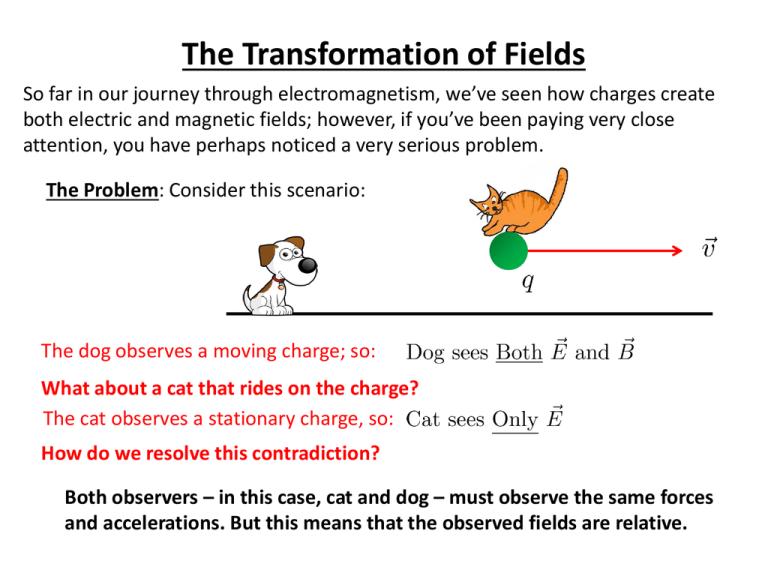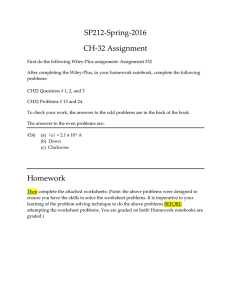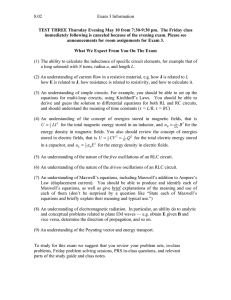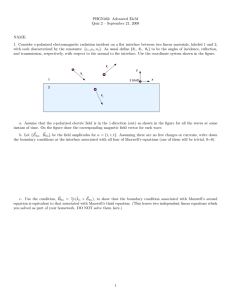The Transformation of Fields
advertisement

The Transformation of Fields So far in our journey through electromagnetism, we’ve seen how charges create both electric and magnetic fields; however, if you’ve been paying very close attention, you have perhaps noticed a very serious problem. The Problem: Consider this scenario: The dog observes a moving charge; so: What about a cat that rides on the charge? The cat observes a stationary charge, so: How do we resolve this contradiction? Both observers – in this case, cat and dog – must observe the same forces and accelerations. But this means that the observed fields are relative. The Transformation of Fields Your author goes through a lengthy (and confusing) derivation of how to transform electric and magnetic fields. He imposes the fact that the two observers must agree on any acceleration caused by fields. This then tells us how the observed fields change. In the language of Special Relativity, we have two frames of reference, S and S’: Observers in S measure: Observers in S’ measure: If we know the fields in frame S: If we know the fields in frame S’: These relations say that there is really only one field, the electromagnetic field. The distinction between electric and magnetic is relative. Note also, these transformations are nonrelativistic; they work only for v << c. Whiteboard Problem: 34-1 A rocket zooms past earth at v = 2 X 106 m/s. Scientists on the rocket have created the electric and magnetic field shown in the figure below. What fields, in component form, are measured by an earthbound scientist? (Define Frames of Reference) Where does the Biot-Savart Law Come From? S (frame of q) P S’ In frame S, observers measure at point P: Observers in S’ observe an electric field and a magnetic field: And in frame S’, the charge has velocity: The Biot-Savart Law! So, the Biot-Savart Law is just the transformed Coulomb electric field! Maxwell and the Equations In the 1860’s, the Scottish physicist, James Maxwell brought together everything that had been done with electricity and magnetism by Gauss, Ampere, Faraday, and others. He adopted the field concept from Faraday, and put everything into a consistent mathematical framework, similar to what we use today. Although he didn’t discover all of these laws, we call them Maxwell’s equations. The Field Equations . . . almost Maxwell’s Equations Gauss’ Law for the Electric Field Gauss’ Law for the Magnetic Field Ampere’s Law Faraday’s Law Do you see a problem with these equations? Maxwell did; there are two ways to create an electric field, but only one way to create a magnetic field. Maxwell believed there should be symmetry. Faraday’s Law says a changing magnetic field creates an electric field; is the reverse true? Maxwell’s Displacement Current Maxell was able to fill in the missing piece by considering a charging capacitor: If you apply Ampere’s Law to Curve C and surface S1, you say there is a magnetic field on C since current goes through S1 But, if you apply Ampere’s Law to curve C and surface S2 , no current goes through S2 , so you say there is no magnetic field on C But, any fool can put compass on C and see there is a magnetic field! What does go through surface S2? A time-varying Electric Field. Maxwell proposed that this would act in Ampere’s Law like a current, the displacement current: (time dependent current) Finally . . . Maxwell’s Equations Gauss’ Law for the Electric Field Gauss’ Law for the Magnetic Field Ampere-Maxwell Law Faraday’s Law Behold Maxwell’s Equations! Combined with the Lorentz Force Law these give a complete description of all (non quantum) electromagnetic phenomena. Along with Newton’s Laws and the Laws of Thermodynamics, this constitutes what we call Classical Physics. Whiteboard Problem: 34-2 A 10 cm diameter parallel plate capacitor has a 1.0 mm spacing. The electric field between the plates is increasing at the rate of 1.0 X 106 V/m/s. What is the magnetic field strength at a) r = 0, i.e. on the axis b) r = 3.0 cm from the axis c) r = 7.0 cm from the axis Your author has a really nice figure comparing the case of a solenoid with time-changing magnetic field producing an electric field and a capacitor with time-changing electric field producing a magnetic field. (This is what’s going on in this problem) Electromagnetic Waves Your author shows that a sinusoidal wave in the electric and magnetic fields satisfies the source free Maxwell’s equations. This is a very tedious and un-illuminating process using the integral form of Maxwell’s equations. With a little more math – things that you’ll learn in Calculus III – you can start with Maxwell’s equations and show that electromagnetic waves exist. This is what Maxwell did. Put Your Pens and Pencils Down! This won’t be on any homework or exams! The Differential Forms of Maxwell’s Equations: Gauss’ Law for the Electric Field: * Gauss’ Law for the Magnetic Field: Ampere-Maxwell Law: * Faraday’s Law: (Curl –E equation) *This is called the divergence, it is a measure of how much a vector field diverges from a point. *This is called the curl; it is a measure of how much a vector field goes around a point. Electromagnetic Waves Maxwell showed that if you start with the source free form of the equations: i.e. empty space with no charge and no currents, the fields behave as: What are these? Perhaps if we look at just the x-component of the electric field equation: This is a wave equation! One over the square root of whatever is here is the wave speed. (try it with your calculator) Electromagnetic Waves One solution to the electromagnetic wave equations is a sinusoidal travelling wave: A changing E creates a changing B, and, in turn, a changing B creates a changing E. The whole disturbance then propagates in space. PhET radiating charge PhET antenna





